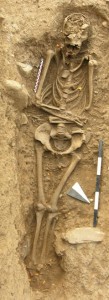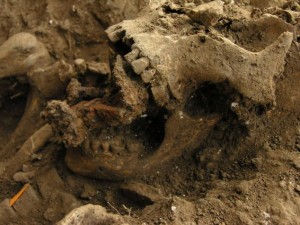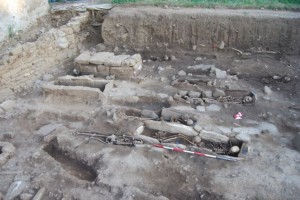 An archaeological team excavating the Tuscan port town of Piombino hoping to find the remains of its patron saint has instead uncovered the skeletal remains of two 13th century women of questionable repute. Approximately 25-30 years old at time of death, they were both buried in the bare earth, without a coffin or even a shroud, very much against custom.
An archaeological team excavating the Tuscan port town of Piombino hoping to find the remains of its patron saint has instead uncovered the skeletal remains of two 13th century women of questionable repute. Approximately 25-30 years old at time of death, they were both buried in the bare earth, without a coffin or even a shroud, very much against custom.
One of women had seven curved, one-and-a-half-inch-long nails placed in her mouth after death and 13 more nails jammed into the ground all around her body. Archaeologists speculate that the ones around her body were used to nail the body to the ground in some kind of exorcism ritual to prevent her using witchcraft to rise from the dead.
The other woman was buried with a leather pouch holding 17 bone dice. Games of chance were against civil and ecclesiastic law during the Middle Ages, and although the laws were constantly flouted, a women associated with dice was a woman associated with immorality. Also, 17 was and remains an extremely unlucky number in Italy. (The story I’ve heard about why it’s unlucky is that the Roman number for 17, XVII, is an anagram of “vixi” which is Latin for “I have lived” which is just like saying you’re dead and is therefore an ill omen. No idea if that’s true.)
 L’Aquila University archaeologist Alfonso Forgione, the dig leader, notes that these burials are unique in his experience. Not only are they strangely bare and contain those odd accouterments, but they are also in consecrated ground. There’s a chapel on the grounds purportedly marking the burial spot of Saint Cerbonius, the sixth century A.D. bishop and patron saint of Piombino. The team was looking for the saint’s burial and for the remains of a medieval cathedral that was once dedicated to him when they found the ladies. If the women were social outcasts, one of them demonic, the other degenerate, neither of them worthy of a decent burial, how come they got to go to their eternal rest in a cathedral cemetery next to a saint?
L’Aquila University archaeologist Alfonso Forgione, the dig leader, notes that these burials are unique in his experience. Not only are they strangely bare and contain those odd accouterments, but they are also in consecrated ground. There’s a chapel on the grounds purportedly marking the burial spot of Saint Cerbonius, the sixth century A.D. bishop and patron saint of Piombino. The team was looking for the saint’s burial and for the remains of a medieval cathedral that was once dedicated to him when they found the ladies. If the women were social outcasts, one of them demonic, the other degenerate, neither of them worthy of a decent burial, how come they got to go to their eternal rest in a cathedral cemetery next to a saint?
Forgione speculates that they may have had the advantage of powerful friends and families surviving them who arranged for them to have at least a chance at heaven by ensuring their bodies were placed in consecrated ground.
 The excavation will continue through the end of the month. They have already found 350 burials in four eight-by-ten meter (26 by 33 feet) sites on each side of the chapel, and there are strong indications that the cemetery goes on for another 65 feet inland and another 33 feet or so towards the sea. Such a large, well-populated cemetery indicates that little Piombino, the only known Etruscan port city, remained a thriving town through the Middle Ages.
The excavation will continue through the end of the month. They have already found 350 burials in four eight-by-ten meter (26 by 33 feet) sites on each side of the chapel, and there are strong indications that the cemetery goes on for another 65 feet inland and another 33 feet or so towards the sea. Such a large, well-populated cemetery indicates that little Piombino, the only known Etruscan port city, remained a thriving town through the Middle Ages.
Archaeologists are working against the clock, though. The cliff side is eroding faster than they can dig. There are bones visibly jutting out, to the delight of many a tourist taking a romantic walk on the beach, but they can’t be removed for fear that the entire promontory will crumble like a Jenga game.
Killing young women of questionable repute in the 13th century is not very different from allowing the inquisitorial courts to become systematically involved in hunting and killing witches in the 15th century. No coffin, no shroud, piercing nails, games of chance – those poor women must have certainly flouted local beliefs about good women and bad women.
It certainly suggests as much. Unless perhaps the morally compromised lady just really loved her dice.
Well now all that’s disturbed. I guess if archaeologists start dropping off, we’ll know the truth.
Nailing the corpse to the ground is the original purpose for ‘staking’ a vampire (or any other form of the legend in Europe.) The stake was supposed to be holding it down, not merely stuck in the heart as Hollywood has it, though.
:skull: :skull: :skull:
I did not know that. /Carson
That’s very interesting to know. It’s makes more sense that way.
Perhaps these were illicit burials, done without the knowledge of church officials. There have been recent news reports of modern cemetery workers burying their trash in the cemetery for years, so it’s not a reach to think that medieval cemeteries may have been similarly misused. The women may have been victims of a 13th-century serial killer who found the cemetery to be the perfect place to bury extra bodies.
I like the way you think. There’s a time traveling serial killer book in there somewhere. He’ll need a more consistent modus operandi, though, because right now he’s all over the place.
Hmmmmmm… the comment I posted was supposed to go under edahstip’s comment regarding the stakes. oops! :blush:
edahstip is right about the theme not allowing threaded comments unless I post a reply through the Admin Control Panel. I just manually changed yours, though, to see if it would work. It kinda half works. I really, really need to just bite the bullet and switch to an upgraded theme.
Only liv has the power to respond directly to comments. Supposedly it’s due to the theme not working after a software upgrade, but that sounds a bit too convenient to me. :shifty:
Is it possible they thought the consecrated ground would act as a supernatural jail, keeping the ghost witches from bothering good, clean people?
I suppose so, but it would be contrary to standard practice. Only faithful Christians got to be buried in consecrated ground, that means no heretics, suicides or unbaptized babies. Witches fall under the first category.
I would imagine that as livius wrote, the women had someone powerful enough to get the church to officially overlook the women’s supposed crimes either due to direct influence or else to avoid angering the patron(s). The grave objects were likely added by the people who actually preformed the burials, begrudgingly.
livius, another way to stop the dead from returning was burying the corpse upside down, so whey they tried clawing their way out, they ended up going down instead. Apparently the dead weren’t supposed to be very bright.
The official church position was that only God could bring the dead back. Sightings of non-saints returning from the dead (revenants, vampires, draugir etc…) were actually demons taking the form of the deceased. This didn’t change popular opinion. This leads me to think that the nails in that grave were added on a local level and likely not by clergymen.
So only faithful Christians or those with money and power…that is so unlike the Church I am stunned over here 😉
I hadn’t picked up on this in the local media (“local” being Florence). As you say, the burial in consecrated ground is rather a puzzler. Piombino, however, remained a “Wild West” sort of place until fairly recently–between civil and religious jurisdictions. With a long tradition of doing things their own way.
Sounds like my kind of place: an amoral no-mans-land of dice games, witchcraft and delicious seafood.
Hello Edward,
I was very pleased to learn that someone as busy as you found time to peruse my little
endeavor into the world of words.
I stand before a master, and I really am touched that you replied to my Red Velvet Cake diatribe! lol [I still don’t get the big deal behind them!? ha!]
I will now write about this little exchange, if you mind, that is!:hattip:
I want to tell you that you have an exceptional way of describing all that you’ve encountered and all that you wish your readers to envision and I for one,
am grateful for your skills.
I must now take leave, as I have a very important blog I need to get back to..
Yours! lol (It’s my fave, lol) 😎
[why don’t these emoticons work here?]
Please keep on writing for me,
Belinda Chinea
New York City
October 2nd, 2011
wow interesing